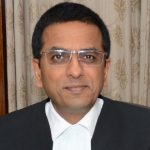 Professor Satya Narayan Misra in Bhubaneswar, September 9, 2024: Responding to a batch of petitions against the order to bulldoze the houses of alleged accused, two judges of the Supreme Court, Justices Gavai & Vishwanathan, have decreed that the law does not allow the razing of homes of the accused and have suggested framing Pan India guidelines and digitize the process, much like the Vishakha guidelines issued in 1997 to deal with sexual harassment of women in their workplace.
Professor Satya Narayan Misra in Bhubaneswar, September 9, 2024: Responding to a batch of petitions against the order to bulldoze the houses of alleged accused, two judges of the Supreme Court, Justices Gavai & Vishwanathan, have decreed that the law does not allow the razing of homes of the accused and have suggested framing Pan India guidelines and digitize the process, much like the Vishakha guidelines issued in 1997 to deal with sexual harassment of women in their workplace.
Retributive justice gives proportionate punishment based on the crime committed; an eye for an eye as in the Old Testament. Immanuel Kant pitched for it. The court has asserted that bulldozer justice will not be meted anywhere in the country. As may be recalled, the bulldozer has become a political tool in the state of UP, as a power statement. Called Bulldozer Baba, CM Yogi in UP was followed by Shivraj Chauhan, CM in MP for a similar type of demolition in April 2022.
Max Weber wrote in Politics as a Vocation (1918) that the state has a monopoly on the legal use of force. But he also wrote that using force for effective governance is unnecessary. The Court used its writ to stop the demolition drive in Jahangir ordered by MDC, New Delhi recently.
When Solicitor General Tushar Mehta brought to the Court’s notice that Municipal laws provide for the demolition of illegal structures, Justice Gavai pointed out that such demolitions are the exceptions and not the norm. He hastened to add “We are not protecting any unauthorized structures, even temples”. Advocate Dave, arguing against the government’s high-handed bulldozer justice made a passionate plea that the right to a home is an integral part of the right to life. The Supreme Court in Chameli Singh Case (1996) had decreed that right to shelter is part of right to life.
This brings to memory the iconic Olga Tellis Case against BMC (1985) when the pavement dwellers and slum dwellers in the Kamraj Nagar slum area were forcibly evicted from their huts under the BMC Act 1888. Olga Tellis, the intrepid editor of Asian Age along with two slum dwellers argued before the Supreme Court that the right to livelihood and shelter is part of the fundamental right to life. She also argued that the procedure followed for eviction without notice is patently arbitrary and unreasonable, as it deprives affected citizens of the right to natural justice, to be heard.
 In a landmark judgment CJI YV Chandrachud upheld the contention that the right to life includes the right to livelihood, the reason why these slum-dwellers have migrated to Mumbai city in search of jobs like hawkers and workers. Referring to Article 39(a) , which enjoins upon the state to provide adequate means of livelihood, and Article 41 which talks about the right to work, the Court observed that ‘it would sheer pedantry to remove the right to livelihood from the ambit of Article 21. The court was realistic enough to observe that the state may not be compelled to provide adequate means of livelihood and work, but any person deprived of his right to livelihood can challenge the deprivation as offending the right to life.
In a landmark judgment CJI YV Chandrachud upheld the contention that the right to life includes the right to livelihood, the reason why these slum-dwellers have migrated to Mumbai city in search of jobs like hawkers and workers. Referring to Article 39(a) , which enjoins upon the state to provide adequate means of livelihood, and Article 41 which talks about the right to work, the Court observed that ‘it would sheer pedantry to remove the right to livelihood from the ambit of Article 21. The court was realistic enough to observe that the state may not be compelled to provide adequate means of livelihood and work, but any person deprived of his right to livelihood can challenge the deprivation as offending the right to life.
On the question of procedure prescribed in Section 314 of BMC Act which empowers the Commissioner to evict without notice, the judgment was bit evasive. On the other hand, Justice Jeevan Reddy in 1980 had ruled that the principle of natural justice knows of no exclusionary rule. Non-observance is prejudice to any man. CJI Chandrachud, without striking down S314 of BMC Act made a specious statement that the Commissioner should have granted a hearing.
Be that as it may, the Court did not agree with the contention of the BMC that the slum dwellers were criminal trespassers under S 441 of IPC. It referred to a survey conducted by Dr Muttagi of TISS in 1972, 77, 79 and 81 as per which the pavement dwellers are a peaceful lot, 53% of whom were self-employed as hawkers and 38% were wage employed. The Court was of the view that the stand of the government showed prejudice against the poor and destitute.
The substantive relief that the court gave was that the slum dwellers should not be evicted at least one month after monsoon season. The Court also suggested that steps should be taken to offer alternative places to the pavement dwellers who were censured in 1976. But this was not a condition precedent to the removal of encroachment. The judgment had a massive impact in halting massive eviction plans of the government. Housing rights jurisprudence has evolved considerably. In Narmada Bachao Case (2000) the Supreme Court ordered adequate resettlement of displaced persons but in reality they were not resettled properly.
 The right to shelter is still not a fundamental right like the right to education in India. This is unlike South Africa’s progressive Constitution, S 26 of which gives rights to ‘everyone to have access to adequate housing. It also guarantees minimal suffering if people become homeless as a result of eviction. Susan George writes in her book ‘How the Other Half that Hunger may have been the human race’s constant companion and the poor may be always with us, but in the 20th century, one cannot take the fatalistic view of the destiny of millions of fellow citizens. Their condition is not inevitable but is caused by identifiable forces within the province of rational, human control’.
The right to shelter is still not a fundamental right like the right to education in India. This is unlike South Africa’s progressive Constitution, S 26 of which gives rights to ‘everyone to have access to adequate housing. It also guarantees minimal suffering if people become homeless as a result of eviction. Susan George writes in her book ‘How the Other Half that Hunger may have been the human race’s constant companion and the poor may be always with us, but in the 20th century, one cannot take the fatalistic view of the destiny of millions of fellow citizens. Their condition is not inevitable but is caused by identifiable forces within the province of rational, human control’.
The spate of bulldozing in states like UP, MP, and Delhi under the cover of the Municipality Act is an affront to our governance’s failure to mete out basic socio-economic justice of decent livelihood, and shelter for all our citizens. It may be recalled that in May 1976, Sanjay Gandhi launched the slum clearance drive of Muslim residents in the Turkman gate area which led to the death of many protesters who were run over by bulldozers. Forcible sterilization and bulldozing slum dwellers are often touted as prime reasons for Mrs. Gandhi’s electoral rout in the general election in 1977. She did not pay heed to many of her associates and the brutality being perpetrated by her son Sanjoy.
As Santayana said, ‘Those who forget the past are condemned to repeat it.’ The Supreme Court’s status quo intervention brought relief to residents of the Jahangipur area. But this is no answer to the larger overarching questions related to the perceived targeting of certain sections of society and the arrogance of state power to use force legally and ruthlessly. The denouement to the Supreme Court’s final order to carve out a reasonable guideline for eviction and demolition will be keenly awaited. Quite clearly retributive bulldozing has no place in a plural, multi religious society like India.


Leave a Reply
Be the First to Comment!